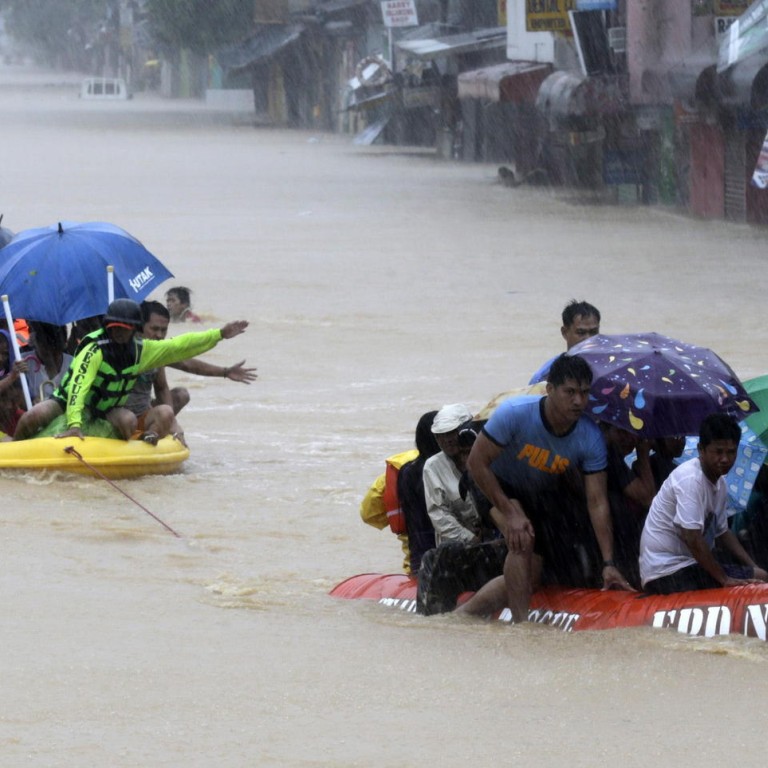
Update | Five dead and 83,000 evacuated as Storm Fung-Wong hits Philippines
Massive flooding as latest storm to hit the Philippines causes river in Manila to burst its banks, swamping heavily populated districts
Tens of thousands of people fled roof-high floods and at least five people died in the Philippine capital and nearby provinces yesterday as another vicious storm swept across the disaster-prone country.
Rescue workers in trucks and rubber dinghies plucked residents from the tops of flooded homes, after one of Manila's major rivers burst its banks, swamping heavily populated eastern districts. It was one of the worst floods to hit the sprawling metropolis of 12 million in recent years.
"We're dealing with floods over a large area," Mina Marasigan, spokeswoman for the National Disaster Risk Reduction and Management Council, said.
She said the first known fatality was a two-year-old girl who drowned at a flooded slum in northern Manila. The Philippine Red Cross said a man drowned in the Caloocan City district, while officials in Rizal province said the body of a 68-year-old woman was recovered after she was swept away by floodwaters.
The winds from Storm Fung-Wong, known locally as Mario, were relatively weak, with recorded maximum speeds of 85km/h and gusts of up to 100km/h as it brushed past the northeastern tip of the main island of Luzon around noon local time.
However, it brought heavy downpours - more than three weeks' worth of rain - overnight across Manila, more than 400km to the south. Weather forecasters said 268mm of rain had fallen on Manila in 24 hours.
Alexander Pama, who heads the government's disaster-monitoring agency, said more than 470,000 people were affected by heavy rain and floods.
The hardest-hit area appeared to be the Marikina river valley in eastern Manila, where swiftly flowing water rose at least a storey high in heavily populated communities near its banks.
Rescuers aboard rubber dinghies, some motorised and some powered by paddles, plucked people from flooded homes.
People held on to lengths of rope to get to high ground safely and avoid being pulled by the strong currents.
Marikina mayor Del de Guzman said that at least 27,000 of his constituents had to be evacuated.
"The scenario is getting worse. The flood waters are rising. Our rescue teams are stranded in major thoroughfares," said Kit Nieto, mayor of the nearby district of Cainta, where 7,000 other people were evacuated.
In all, flooding forced at least 83,000 people to flee their homes in and around Manila.
Schools and government offices were shut, while flooded streets caused traffic gridlock, with many motorists unaware of the extent of the flooding.
Manila airport authorities said the rain and radar problems caused delays and the cancellation of at least 28 domestic flights to and from the northern and central Philippines.
Six international flights were diverted to Clark International Airport in Pampanga province, 80km north of Manila.
The Philippine Stock Exchange suspended trading and some banks sent their employees home during the morning.
Fung-Wong struck just a week after Typhoon Kalmaegi hit the same area, killing eight people and displacing more than 366,000.
An average of 20 typhoons hit the Philippines each year, killing hundreds and bringing misery to millions.
Many Manila residents were upset that long-neglected infrastructure had contributed to the flooding.
The north Manila bungalow of lawyer Ghelynne del Rosario was swamped by chest-deep floods, forcing her, her mother and grandmother to wade to the safety of a neighbour's two-storey house.
"I am angry that I have to do this each time it rains hard," she said, cradling one of her pet dogs, as her two other dogs swam beside her.
